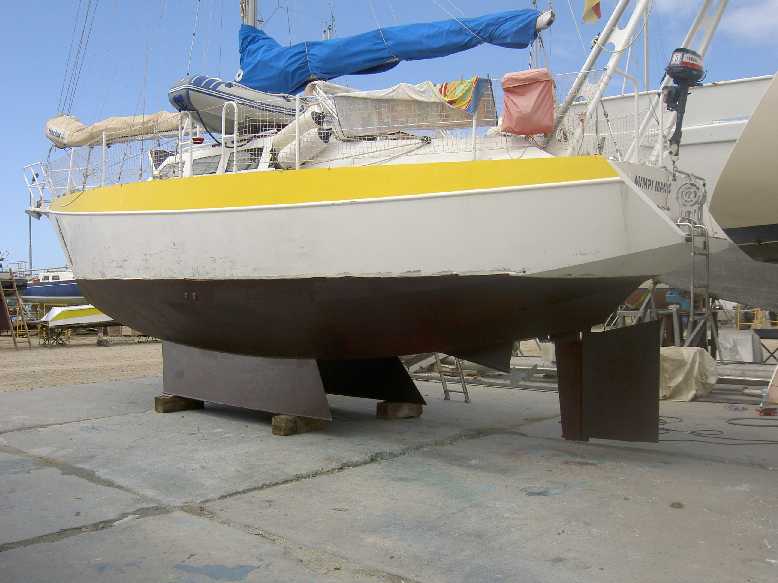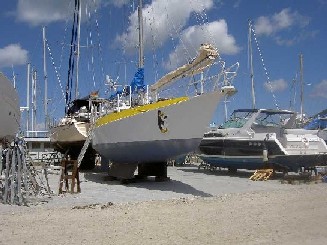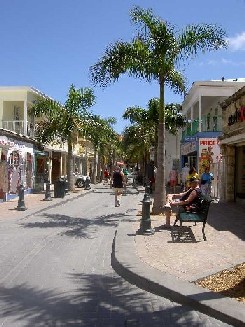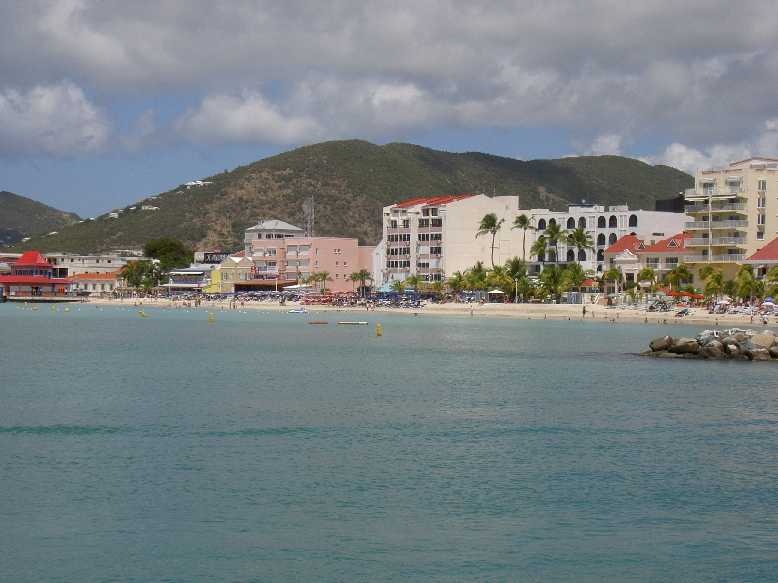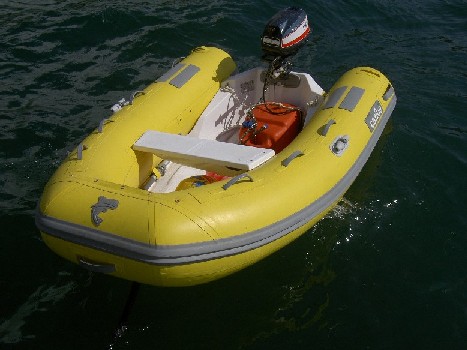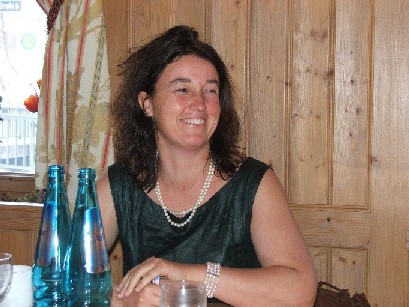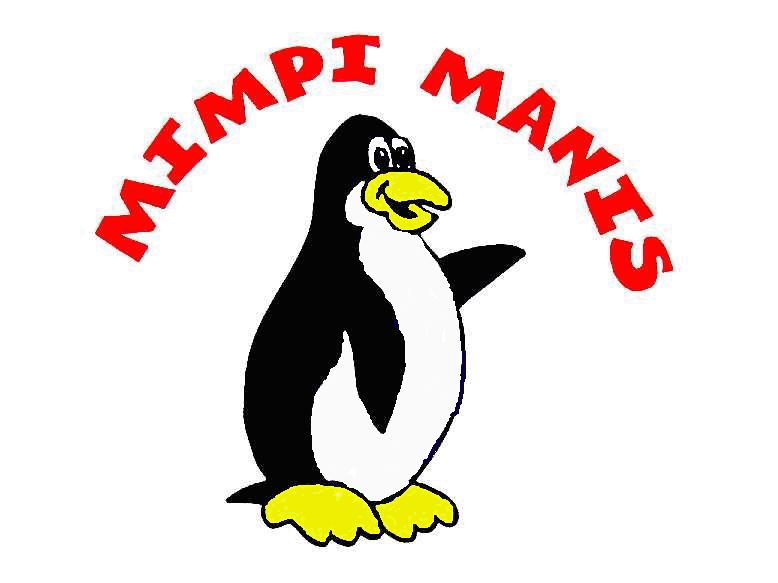
MIMPI MANIS
A family's dream of freedom becomes true
Diary
2006
January: 2006 has started! Last year we were still working on „Mimpi Manis“ despite the cold winter with its snow and ice and this year? This year we are on the Canary Islands and preparing for the long leg across the Atlantic. But first we are doing a day trip to Lobos, a small island 10 miles south of Lanzarote. The family wants to know if and how „Mimpi Manis“ can sail. 10 people on-board is making „Mimpi Manis“ really tiny. Sailing to Lobos was finest downwind sailing and we arrived there after only 1 ½ hours. Unfortunately the weather we had and the one predicted by the weather forecast were not the same. Sun was missing and so nobody was in the right mood for swimming or diving. So we ate the home-made cake and our nephews strolled around the boat and got lots of explanations. When we started to sail back we noticed that the wind has changed to N instead of the predicted NE and still blowing with 5 bft. so we had to tack on our way back to the harbour. It was a cold day, but nevertheless everybody enjoyed this trip and after having warmed up again, our family left for their hotel.
Although we thought that we had bought everything needed, some items were still missing. Our shopping list still listed some things like a new solder, the old one stopped working a few days ago, some screwing chucks, one broke and another one felt into the harbour. Also a spare stopper for the rinsing sink, a new coffee-pot, the old one slivered to pieces although said to be unbreakable. Our Spanish was once more tested when it came down to organize a grease pump and several chemicals, like Natriumbissulfit or hydrochloric acid. Those words are not listed in our dictionary and so we tried to explain our wishes using hand and feet. Although some of the dealers gave up, we were able to buy most of the items needed. Only the chemicals were missing when we carried our stuff onto „Mimpi Manis“ at the end of the day.
Having finished our shopping by noon we had some time left for sightseeing. Grandmother and grandfather, who accompanied us while our shopping tour and the three of us visited the Fundación César Manrique, the former house of the famous island-architect. Nowadays it is used as a museum. Grandfather and Stephan tried to struggle but in the end they had no chance to resist the demand of 3 women. They would have preferred to stroll around at a shipchandler or screwshop instead of walking through the former house of Manrique and looking at all the modern art exposed. But in the end they agreed that it was worth visiting. Stephan: „semi-nice!“ If Stephan is calling art „semi-nice“ then he must have been really impressed.
On our way back to Playa Blanca we stopped at a supermarket and stocked up on items like toilet-paper, milk, beer, .. and the shopping-cart once more was filled to its top. When we tried to stow away all the stuff we realized: „Mimpi Manis is full!“ She's not overloaded but we now have used up all accessible space. So no more shopping tours before we leave for Gomera on the 10th of January.
We spent the remaining days with our family. Lena is enjoying her time on the beach while playing in the sand together with her cousins Verena, Manuel and Johannes. But time is running fast and on the 8th of January they all must leave as school or work starts again next day. Saying good-bye is always so sad and tearful for everyone. When will we see them again? Hopefully soon. They fly home and we sadly walk back to our boat. We are also leaving in two days and there's still a lot to do. Some screws to be tightened, some items to be stowed away, doing some laundry and of course cleaning the ships interior. When Flo will arrive on Tuesday we will leave the same day afternoon as the weather forecast is excellent for the 40 hours trip to Gomera.
We are getting nervous, not sleeping during most of the night, we worked on the computer to finish the update of our website till 6 o'clock in the morning. None of us was tired and so it was good to have something to do instead of lying in the bed and thinking of everything and nothing at the same time. During the night there was quite a strong wind and so we hoped that it will calm down a bit till the afternoon. Looking out of the hatch in morning indeed promised a beautiful day with sun and no clouds but while looking around we missed our buggy, who should be standing on the jetty right next to “Mimpi Manis”, where is it now??? Shit!!!! There are only two possibilities either somebody has stolen it or it fell of the jetty into the water! But who steals a buggy, we could not believe this theory. And indeed there was enough wind tonight to blow a buggy into the water. Why didn't we put the buggy onto the boat last night? But now it's too late, one of us has to dive and look at the bottom of the harbour for our buggy. As none of us was eager to dive, we threw a coin and ? Evi lost. So she got into her wet-suite and had to dive into the 4 m deep harbour. Water temperature was 18° and no breakfast yet. To see anything down there is not easy as the water is not clear and sight is limited to less than one meter. Also a cold wind is blowing as it is still early in the morning! It takes some time for Evi to find the buggy. Evi is not known for having a good orientation and below water it is even worse. But in the end she succeeded and we were able to bring the buggy back on the jetty, water it with lot of sweet water and have it dried till the afternoon. We are all happy that Lena's favourite transportation cart is back again.
Stephan and Flo are back at noon and Flo is shown around having explained the most relevant parts of the ship. Where is the life-raft, where is the beer! At 5pm we leave Marina Rubicon having berthed there for 6 weeks for the 40 hours ride to La Gomera.
Sailing to Gomera was finest sailing just from the start. 5 to 6 bft directly to the stern made the journey comfortable. But in the morning of the second day the NE vanished and only its waves were left. Additionally a swell from the SE also came up and so we were rolling and rolling. 50% of the crew got seasick and were feeding fishes. Even Stephan known to be insensitive to seasickness lost his appetite. Lena was the only one to eat everything and emptied all glasses we prepared for her. The waves were up to 2m and no wind to stabilize „Mimpi Manis“. So we started the engine and tried to continue. But even making miles into the right direction we continued to roll severely from left to right and back to left again. It's no fun to sail like this and we all hoped that the waves will calm down soon or wind will rise. It was about this time when Oscar our tiller-pilot stopped to work. So having watch meant to really steer the boat and not to look if everything is going well every 15 minutes. While Evi's watch she had an attack of a strong-man act and broke off the wooden tiller. But we were able to steer with the left part and at that time wind came up again and so we could use Fridolin our windvane steering to steer us to Gomera. Setting sails made a great change in the behaviour of „Mimpi Manis“ as she now was smoothly going up and down the waves instead of rolling. Next morning we arrived in San Sebastian, main port of Gomera. Just after having berthed we started to work on our maintenance list. We made use of our spare plywood to shape a new tiller and had it painted several times to make it resistant to salt-water. We also opened Oscar just to see that this will be a case of warranty and that we are not able to repair it. A small magnetic pin has come off and crushed an electronic board. So the electronic did not know any more where the steering bar was standing and pushed it beyond its extreme point.
Next day we rented a car to drive across the whole island . We also made a 2 hours walk on the top of Gomeras highest mountain, called Alto de Garajonay (1487m). On top of this mountain the temperature was as low as 8°C and we were freezing. But altogether it was worth doing this tour as it was not difficult to follow the path and it was not too steep either. Lena had the easiest part as she could ride on papa's back and enjoy the views on the landscape of Gomera. After that we went to the Valle de Gran Reye for lunch and continued clockwise visiting the villages of Vallehermosa, Agulo and Hermigua. The circular road lead through astonishing landscapes and got from nearly 0 to 1000m within short distances and down again. Next time we come to Gomera we will do the same tour with a motorcycle. We enjoyed the green island very much as we only had the dryness and greenlessness of Lanzarote and Fuerteventura for the last two months. On our way back to San Sebastian we stopped at a supermarket to stock up on groceries and fruits.
Next morning on the 15th January we bought bread and tried to get an update on the weather forecast. But it was Sunday and all internetcafes were closed and so we prepared „Mimpi Manis“ and ourselves for the next leg to the Cap Verde Islands. We cooked a warm lunch and filled up our watertanks and left at 2:30pm for Sal on the Cap Verde Islands.
On Sunday winds were fair and the waves did not grow higher than 1.5m. But during the night to Monday the wind grew to 6bft and stayed this strong till Wednesday morning. A really not favourable time as the temperature did not climb higher than 18°C and we sometimes got waves into the cockpit. Due to the strong wind we only had our Trecker standing, so „Mimpi Manis“ was rolling again. None did want to have a beer and Flo reduced his meals to one carrot and one banana during one whole day. The stocked apples were rolling around on the floor as they tend to fall of their nets, so they got brown very soon and we tried to keep up with eating them.
Friday 20th January day 6 since Gomera: it's getting warmer now and we can stay outside the salon with T-shirts only and do not need to have a sweater. We even were able to wash Lena's napkins and dry our salted things. And for the first time since we left Morocco we were able to enjoy some red wine as a sundowner in the cockpit. Wind has calmed down to 3-4 bft from ENE and waves have also. Our daily etmals of up to 146miles have shrunken to 116, but it got much more comfortable on board. Today is the first day we were able to serve a warm meal and all three of us could join it. Breakfast consisted of scrambled eggs with lots of onions and garlic. For dinner we had tomato-avocado-salad. Lena had a bad mood the whole day, it got evening till she got „normal“ again. We tried our best with entertainment but reading books or playing with her only helped for some minutes. She's having tooth aches again? We will reach Sal tomorrow!
Saturday 21st January day 7 since Gomera: we finally made it, just before sunset at 7pm we reached the port of Sal and dropped our anchor. As the first two attempts did not went well we needed a third attempt till we were satisfied with the anchoring situation. The whole day we had faint winds and only made 3 to 4 knots and were glad to reach Palmeira during daylight. Having dropped the anchor we prepared ourselves fried potatoes and went to bed soon.
Next day we repaired some minor items and enjoyed the stillness of being anchored instead of rolling. In the afternoon we went ashore and Lena made use of her sand-toys. After that we walked through the tiny village with only a few trees and dryness everywhere. Sal is one of driest island on the world. The people are friendly but rather distant. Rudi and Andi an Austrian couple made friends with us. They are sailing with a 9.5m boat and could fill long evenings with their previous travels. Driving through Africa from Burkina Faso to Southafrica, driving from Europe to Nepal or sailing in a 6m boat from Sri Lanka to Singapore, ... We invited them for some red wine and made an appointment for the next day to go to Espargos, the capital of Sal for using the internet and stocking up on groceries and fruits. Flo was „allowed“ to take his big backpack with him and we filled it with more than 20kgs of food. In the afternoon we checked „Mimpi Manis“ and realized that we had salt-water in the engine room and sweetwater in the main bilge. Causes? The exhaust hose came off the swanneck and so seawater could flow into the engine room while motoring. And the sweetwater? This was the fault of the captain as when installing the watermaker he tried to simplify things and so the sweetwater from the watermaker could flow into the bilge via the ventilation hose. So he had to do the work twice. We went ashore for dinner and it indeed was very tasty and cheap but to wait for 1 ½ hours was just too much for Lena and she became some kind of nervous and felt asleep when going back to “Mimpi Manis” with our dinghy.
Tuesday 24th January, day 1: we adapted our clocks and watches to the new time zone of Antigua. From now on our board-time will be AST (Atlantic standard time) and therefore UTC -4 hours. So sunrise will be 4am and sunset at 3pm! Rudi and Andi dropped by for a last goodbye, they are also leaving but they are heading for Trinidad and want to do a stopover on Sao Nicolao. Rudi also demonstrated his fishing bait. We made a similar bait, weighed the anchor at 8 o'clock AST (11 o'clock local time) and tried our luck with the new bait. And indeed after 3 hours we were lucky and caught a huge golddorade (1.13m), 5kg of pure fishfilet's! But unfortunately none is hungry due to the rolling of the boat. So we put the fishfilet's into our fridge and hoped for the next day. Flo even fed the fishes with the contains of his stomach. If he continues like this he will be only skin and bones when we arrive in Antigua. To be on the save site we needed some distance to the Cape Verde Islands and so we had to sail windward. The wind tends to 5bft and so waves were washing over the deck of „Mimpi Manis“ and some also entered the cockpit.
Thursday 26th January, day 3: yesterday we had lots of wind 5-6bft, sea 5, lots of rolling and so Fridolin sometimes was not able to maintain course and we had to assist him. Reefing part of the main sail enabled him to manage to keep course but then we were rolling more than before! But today winds got a bit lighter and we managed to wash Lena's napkins and prepare her meals for the next days. She got lots of the fish we cought the first day. During the night a tanker overtook us, as close as 0.5 miles.
Tuesday 31st January, day 8: second nice sailing day since we left the Canary Islands. We were able to sail with our 125 squaremeter Blister the whole day and only at sunset we took him down as the risk of a sudden gust during the night is too high and this gust could rip it apart. During daytime you can see the dark clouds and react, but in the night there is no chance at all. During the whole day we had NE 4 bft, lots of sun and temperatures of 28°C below deck and water was 25°C. Sailing with a Blister is nicest sailing as the Blister prevents the ship from rolling. When we switch to main and foresail for the night, we suddenly realized the difference.
Normal daylife is determined by setting and taking down the Blister. Lena is waking up at approximately 5am, demanding for her breakfast (semolina pudding with fruits), after that skip and Flo are changing sails and setting the Blister. Having done that Flo is allowed to go to bed, as he was on duty since 2am. During daytime everyone can eat and drink whenever he likes, only in the evening a warm dinner is served and all crew members are asked to join. Dinner should be served as long as the Blister is in use as this stabilizes the ship and the crew is more hungry. In the evening Lena is romping through the ship till she finally falls asleep and only wants to have her milkbottle. Mama joins her and Flo is also going to bed soon. Stephan is on watch from 6 to 10 pm, Evi from 10 pm to 2 am and Flo from 2 to 6 am. During daytime we also change every 4 hours but then it is not this strict as there is always somebody on deck to keep an eye on everything.
The day before yesterday we had a calm. No winds or a very light one from south. So we started the engine, washed a load of napkins, made some water, filled up our batteries, took the opportunity to have a hot shower, lying in the sun... When the wind came back yesterday morning we set the Blister and moved westward with 3-4 knots. As during the first few days of this trip we had lots of clouds, we enjoyed the warmth of the sun shining down on us. As the waves were nearly non existent the skip could climb up to the salings to warp some adhesive tape around the ends to prevent the sails from rubbing and being rubbed through. Even Evi agreed that this was a “semi fine” sailing day. If Evi is calling a sailing day as “semi fine” it must have been a really nice day!
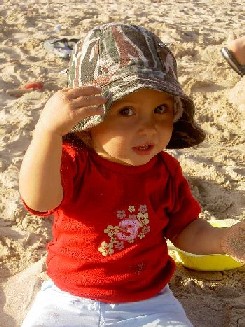
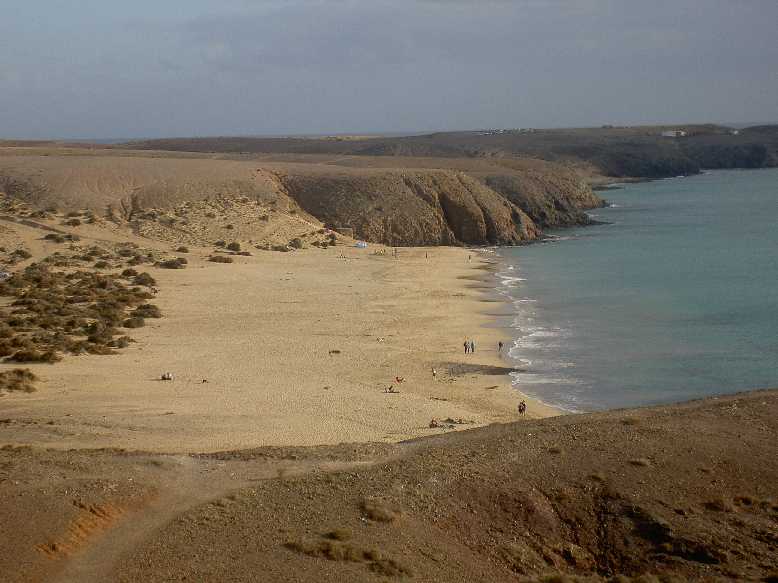
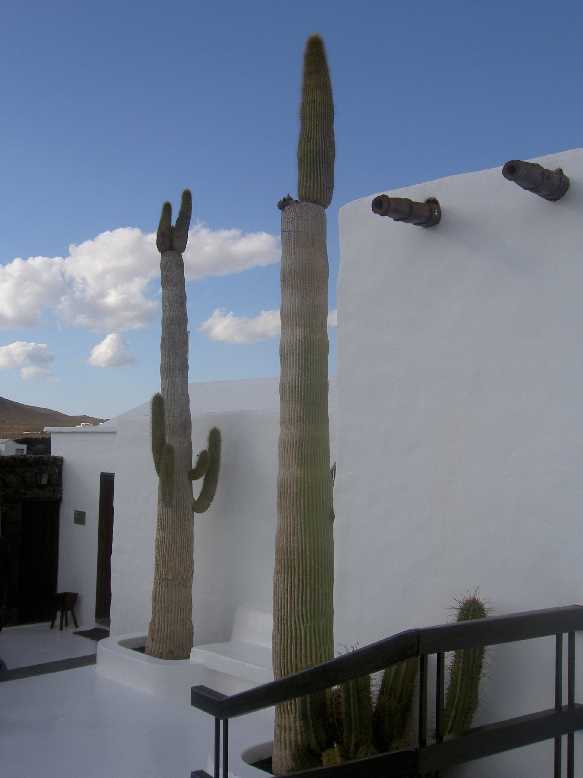
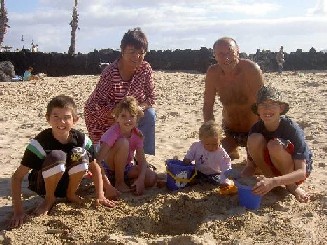
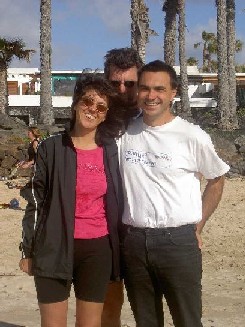
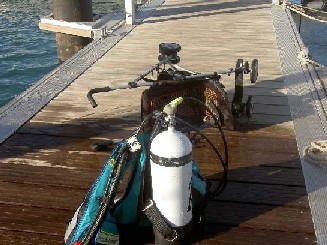
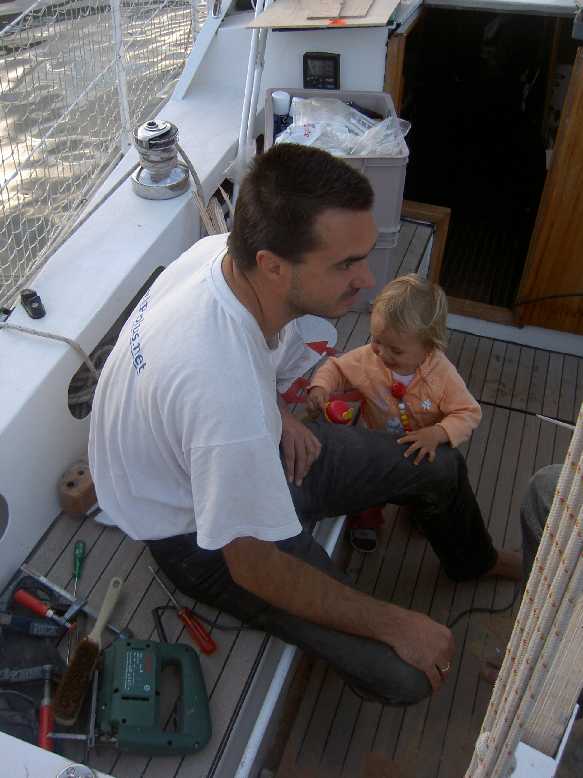
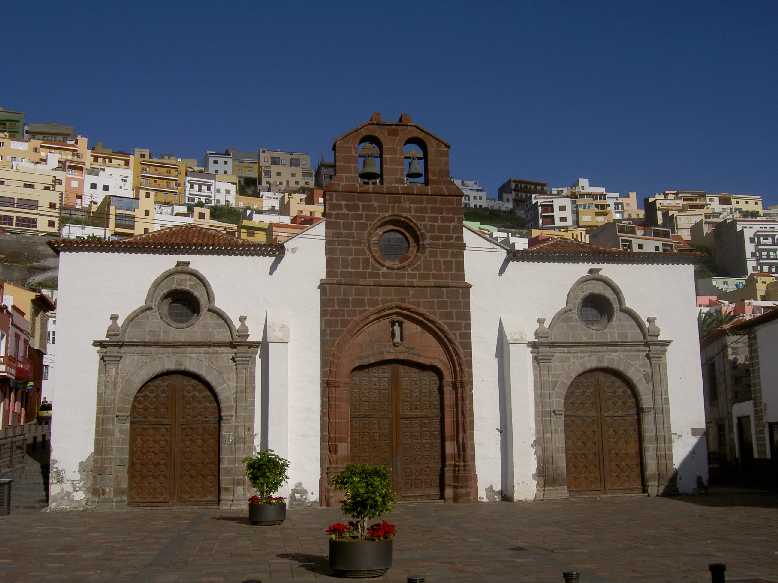
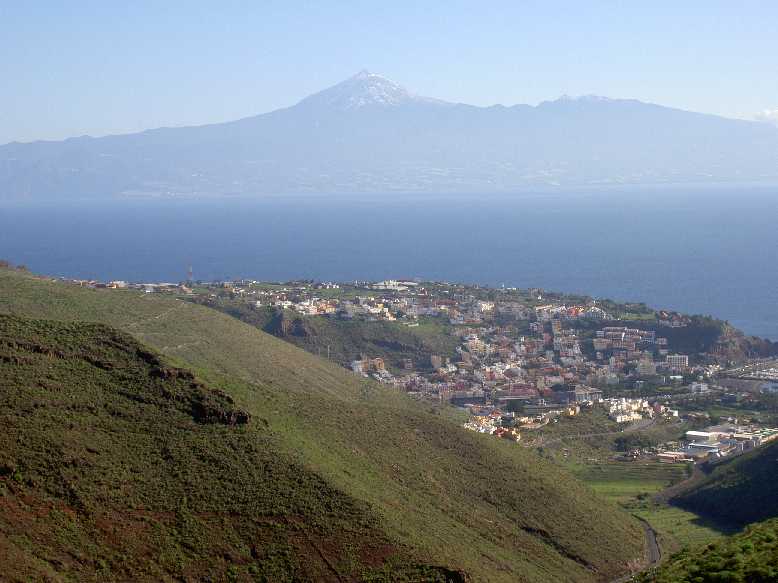
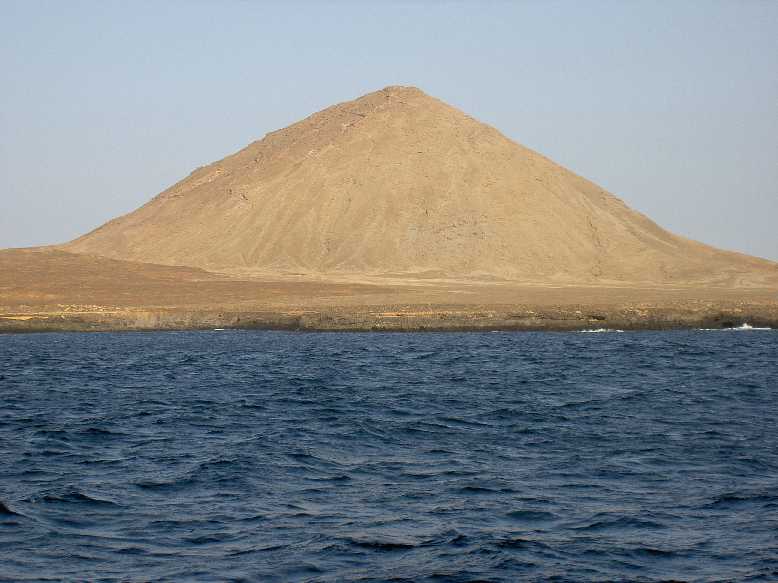
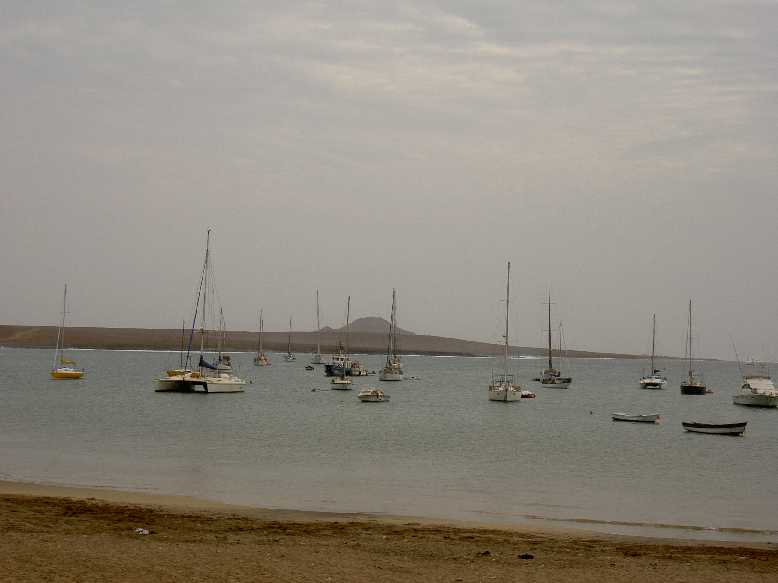
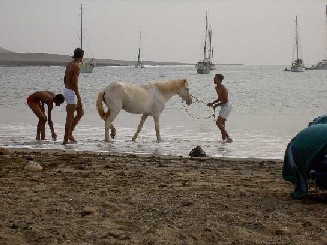
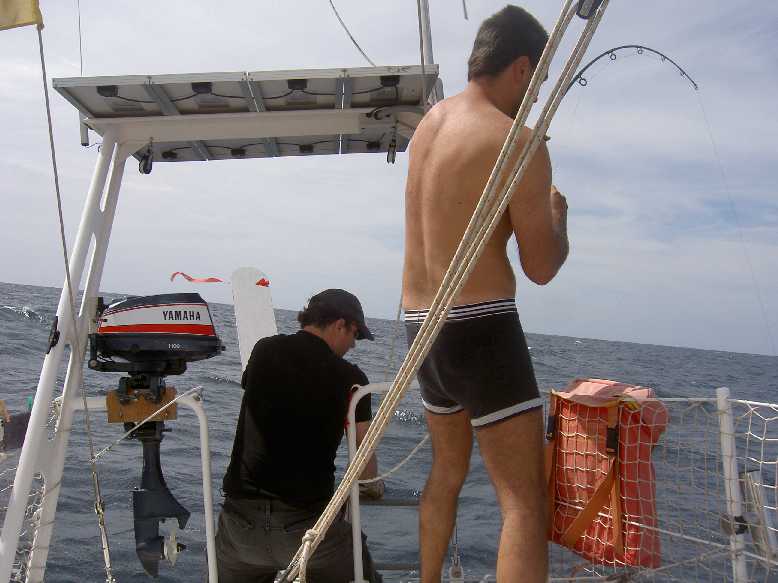
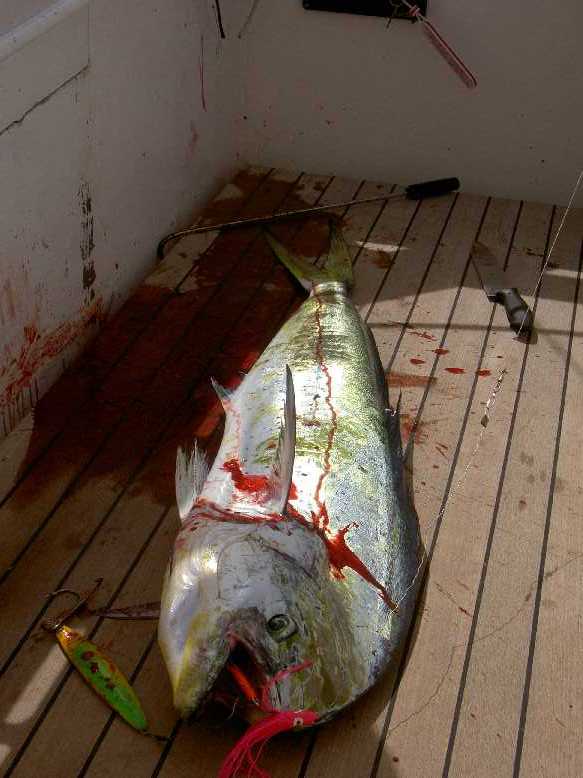
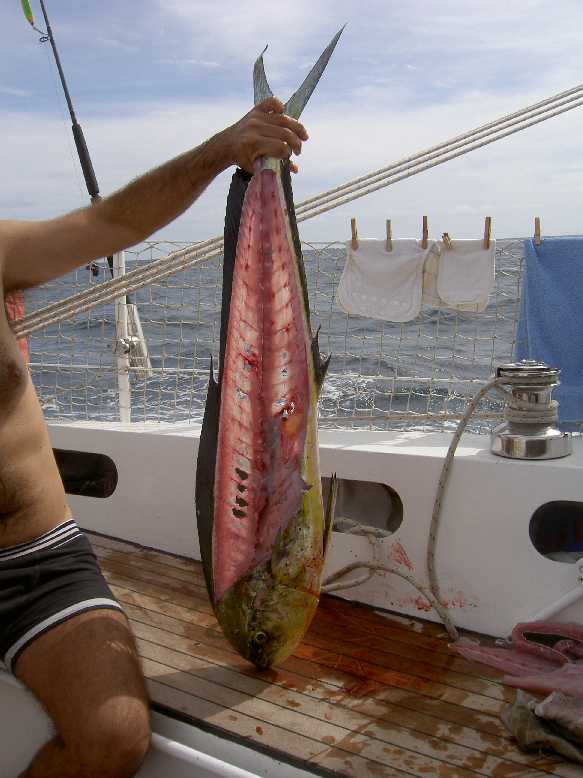
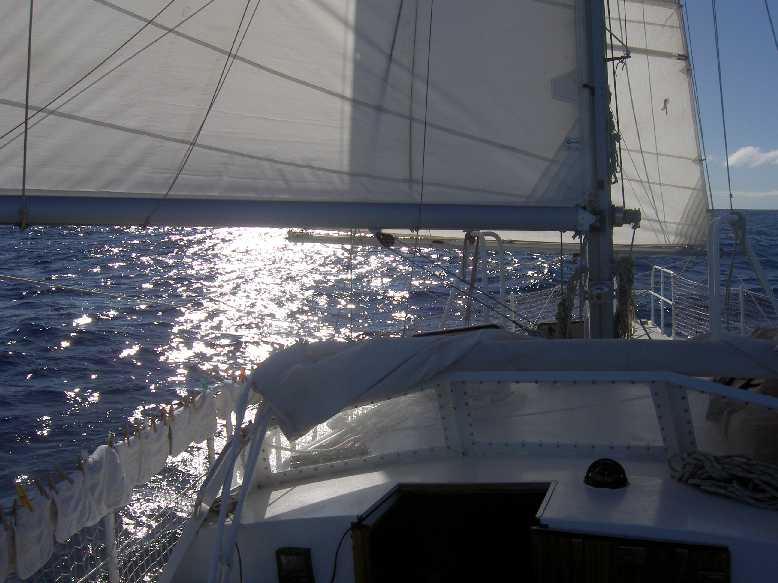
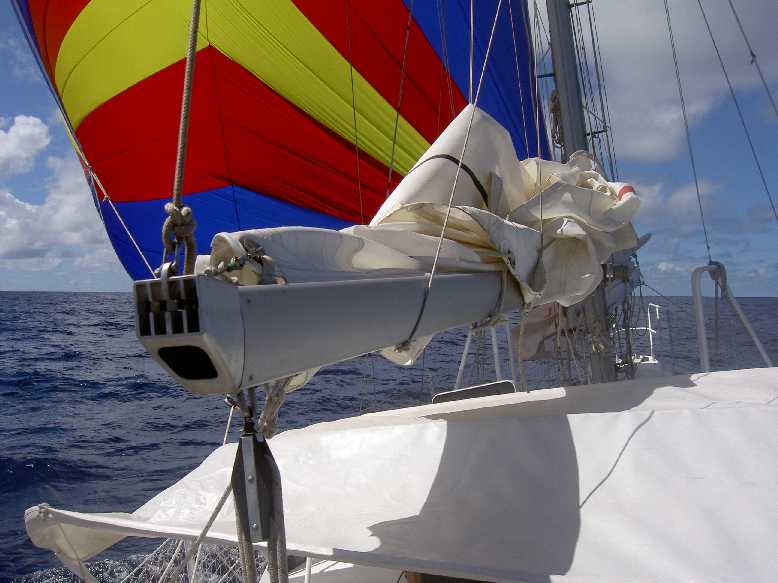
February: Friday 3rd February, day 11: at 2 am a tanker has passed by as close as 400m, we saw him already for several hours closing in. What happened else? It was a calm day apart from a tuna who wanted to join us and jumped into our cockpit. We cut off his fillets and then he was allowed to swim again. Evi made some fresh bread and so we ate poison cru (raw fish with citron juice and vegetables) for dinner, really tasty. The rest of the fish will be served tomorrow evening. During the whole day we had 3-4 bft and therefore our etmal today is only 112 miles. As the waves are still high we are rolling again. Today we had the experience of seeing a live whale close to our boat. Stephan was quite frightened from the breathing of the whale and Evi was so exited seeing this animal only a few meters away from us. Only Flo who wished to see a whale was sleeping at that time and when we got him awake he didn't believe us that there was indeed a whale. Now a routine has come into our daily live, waking and standing up with Lena, having breakfast, playing with Lena, sleeping with Lena at noon for app. 1-2 hours, playing with Lena again and waiting for 5 pm, beginning of cooking! At 6 pm Lena and the rest of the crew is going to bed and only the one on duty has to stay awake and watch out for other ships or changes in weather.
Tuesday 7th February, day 15: last night a squall hit us and it rained so strong that the boat now is desalted! As the squall came with strong winds we were even forced to reef the mainsail! But „Mimpi Manis“ did not stay long desalted as till midday there is again salt all over the deck. In the middle of the night a strange and loud sound woke us all, the sewing machine has fallen out of the cupboard, one of the locks has fallen apart. Why does the To-Do-list grow as soon as we have weighed the anchor for 5 minutes? Having stowed away the sewing machine another cry from Evi, Fridolin is not working anymore! So we tried to fix the problem but when looking at the rudderblade of Fridolin we saw that it is just missing. It's made of aluminium and now on its way to the bottom of the Atlantic ocean 3,500m! It's 1:30 am in the middle of a dark night and now we must hold the tiller with our hands at least till dawn. Maybe the next morning we can make a new blade with some of the spare plywood or we are steering by hand for the next 4 days! And indeed we are able to make a new rudderblade and this one worked well. Thank god that we have lots of tools and staples of spare plywood in our engine room. But in the evening another failure, the warning lamp of our batterycontroller tells us that we are running out of electricity. Searching for the reason of the low batteries for several hours does not reveal a failure. So we started the engine and filled the batteries a bit. There are only 3 reasons why we are running our of electricity: first, we are loosing power over a shunt, second we are not producing enough energy by our solar panels and the windgenerator as after 2 pm the sails throw their shadow on the solar panels and with wind from the back the windgenerator is not turning very fast if he is turning at all. Third possibility: one of our batteries is defect and drawing all the energy provided. The third possibility is not very reasonable as a check of the batteries did not show a defect on any cell, also the second possibility is not reasonable as when sailing in the Mediterranean sea we had no shortage on electricity with our solar panels. To rule out the first possibility we need a better measuring instrument. The one we have is not suitable for our needs and so the skipper will have to be very alert when it comes down to electricity. Conrad is selling very fine instruments and so Evi will have to bring one with her when coming back from Germany in March. And till that time Stephan will measure voltages and resistance of some components and hopefully get a feeling on the defect or even find it. Those Copperworms are indeed very nasty animals.
Saturday 11th February, day 19: at 1:30 am AST (UTC -4) our anchor dropped in English Harbour, Antigua. 2150 miles since Sal, 3134 miles since Gomera. 2914 miles covered by sails, 220 miles with the engine. On both calm days we motored 200miles! Average speed was 5.6 knots and we needed 17 days and 17 hours since Sal or 23 days and 21 hours since Gomera. Our best etmal was 159 miles, the worst one 91 miles. What else: 5 broken wineglasses, one hut flown into the sea, lots of haematomas and a tired but happy crew. We got a bottle of champagne out of our fridge and touched our glasses to finally have covered the long leg and thanked the Atlantic to be so smooth most of the time. As Evi has managed to bake a peachcake the day before we also were able to have a piece of this left over for everyone now. Yesterday? Calms and squalls, rain and wind and only at 5 pm we were able to stop the engine and sail the last few miles to Antigua. So we have enough water for washing the next days as the watermaker was running most of the time while motoring.
After we had finished the the cake and emptied the champagne bottle we went to bed at 3 am. But Lena woke up at 5am and needed some entertainment after her breakfast. In the light of the day we moved to another anchoring place and Stephan went ashore to customs and immigration. As we had no outbound clearance from the Canary Islands the civil agent rocketed and we had to stay calm! EU-ships with a pure EU-crew do not have to check out with the officials when leaving the EU-territory's, but do we really want to tell this to this civil agent? And we left on a Sunday so all offices were closed anyway. It's wise not to tell him that we made a stop over on the Cape Verde Islands! After a few minutes he calmed down again and admonishes us to have an outbound clearance next time we come to Antigua. We promised to do so and thanked him for his kindness.
After passing immigration and taking down the Q-flag we were able to enjoy the new surrounding, green hills, palm trees, white sandy beaches and a very secure bay. English Harbour is worth visiting (anyway it's the only real attraction on Antigua except the sandy beaches and the sea). English Harbour are restored harbour facilities left from the English and built in the 18th century. Nowadays it is used for watersports and their needs and not for warships as in former times. Lots of small companies dealing with the special needs of yachts and a shipchandler have gathered here and fulfil nearly all wishes of yachtsmen. As most of the yachts seeking for technical solutions are 30-80m long (used for weekends by poor CEOs) the prices are much higher than elsewhere in the Caribbean area. A staff of 26 employees including several cooks, servants, nursemaid, chambermaids, ... is regarded as normal. The lifeabords are anchoring in the bay to avoid the astronomical harbour fees and use their dinghy for getting ashore.
Lena does not want to walk, she is shaky! Does she miss the rolling of the ship? But during the following days she is getting much better again and can walk even better than on the Canary Islands. She even learns how to stand up alone without the help of Mama or Papa. After 5 months she “must” join her parents again when swimming in the sea. Since September we had no opportunity to enjoy a warm sea, since we left Ibiza water temperature was always below 20°C. The first days she was very anxious when we went into the sea but she got used to it very soon again. Since we arrived in Antigua Lena is joining the meals of her parents and does not get specially prepared ones any more. We have to get used to meals not this spicy as we are used to and Lena has to learn how to use a fork and a spoon. The first trials ended in lots of food on the floor but she learnt fast and after a couple of days more and more food finds its way into her mouth instead on the floor.
After 2 days in English Harbour we are leaving for Nonsuchbay in the eastern part of Antigua, we want to get away from the noise. But under sail and motor „Mimpi Manis“ is behaving like a clumsy duck, even when we motor with 2000r/min we only make 3.5 knots (normal: 5.5knots). Therefore the skipper got into his wetsuit as soon as the anchor has dropped in Nonsuchbay and took a look at the bottom of our ship and he did not like what he saw. Lots of mussels and algae! So he got his plastic-scraper and pulled of all mussels and most of the algae. It took him 2 hours of diving and scraping. All the mussels would have been a nice dinner for the three of us but those ones are tough and not very tasty. Why did we put this expensive antifouling paint onto the bottom, it does not seem to be really effective, or? We now have a swimming mussels algae breeding and need to take out „Mimpi Manis“ soon for high pressure cleaning and repainting of the bottom. We will not be able to wait till June in Trinidad as till then we will have nothing else than a nonmovable mussel and algae breeding and it can be a long way to sail down to Trinidad when the ship is a clumsy duck.
The first estimate was a hefty 2500$ US. We are not willing to spend more than 1000$ US! When asking around in Antigua we got the real picture that it is impossible for us to do the works on Antigua as first the paint is very expensive here (1000$ US, compared to the price in Germany: 350€) and second no Marina allows us to do the works ourselves and they want 800$ US for the labour. But as we have to adapt the height of the waterline and primer the Aluminium first very carefully to avoid contact of coppercontaining antifouling and aluminium we want to do the works ourself. We'll see what time will bring and keep our eyes open.
So we enjoyed the days in Nonsuchbay: leading an idle life, reading, playing on the sandy beach with Lena, swimming and in the evening playing Trivial Pursuit. But the coral reefs here are not worth diving or snorkelling as the water is a bit muddy due to the mangroves. While living from day to day and hopefully not forgetting to tick one day in the calendar, something totally unexpected happened. One morning the skipper looked out from the salon to the back, to the front and thought on breakfast as he realized that something was wrong. Another look to the back and then he knew: we lost our dinghy! The rope is still fixed to the clamp but it is ending in the water. What to do now? In fact we were not very happy with our dinghy but to loose it now was not the way we want to get rid of it. Our dinghy is not very stable and we get wet even in 10cm waves, so we already had decided that we will look for another dinghy and probably buy one when we meet a suitable and affordable one. Also our outbordengine was fixed to the dinghy and to buy a new one would cost additionally 1000€. And in fact we were very happy with our outboard engine as it started well and did not fail once. So the crew decided that the skipper had to swim ashore and look for the dinghy as it may have landed somewhere and is now waiting to be saved. So he got into his wetsuit and swam ashore. As he, having swum 500m reached the little bay he intended to land, his eyes widened as he saw our dinghy swimming there and waiting to be saved. As it was in the apex of a small bay we were not able to see it as we looked for it from aboard „Mimpi Manis“. Getting it back into deeper water, having the engine started and driven it back to „Mimpi Manis“ was the highlight of the day. So we still have a dinghy also we are still looking for a more suitable one, with a rigid bottom or at least a V-keel.
After a few days in Nonsuchbay we sailed back to English Harbour, as Flo who joined us across the Atlantic had to say good-bye to be in Cologne for the carnival. So we went to the „Admirals Inn“ a highly recommended restaurant to celebrate the Atlantic crossing. 85$ US for three dinner and some beer would have been OK if the meals would have been excellent, but the fish was not very tasty in fact it did not taste like a fish. So we had some red wine while sitting in the salon and discussing the Atlantic crossing once more.
Early in the morning Flo had to wake up to be in time at the airport. He hates waking up before 9am! Last breakfast on board of „Mimpi Manis“ and than he got into his taxi to bring him to the airport for his flight to Germany with a stop over in New York. 1 Meter of snow and temperatures below freezing point are waiting for him. We are sad that he had to leave, as we really liked him. We were glad that he joined us for the Atlantic crossing and he was really a help for us while sailing. Thank you again Flo! And even Lena liked him very much from the first beginning! She even tried not to knock on top of his berth with her toys when he was sleeping not to wake him up.
As soon as Flo has left we took the bus to St.- John, the capital of Antigua and Barbuda and went to the central market for shopping. Prices for greenstuff are much cheaper in St. John than in English Harbour but still higher than in Europe and ten times of what we paid in Morocco. By incident we learnt from a staff-member of the local Sunsail-basis that on San Maarten spareparts and paint is much cheaper than on Antigua and also it is common that all works are carried out by the shipowner himself instead of expensive local companies. As San Maarten is only 100miles away we decide to go there for having „Mimpi Manis“ taken out of the water.
As here in English Harbour the sea is not very clear and also wind is not bringing some refreshness, we decide to spent the last few days in a bay close by (3.8 miles). There we enjoed the days while reading, updating the webpage, staying on the beach with Lena, ... till Evi and Lena are flying back to Germany for her best friends wedding, Evi will be one of the witness to this marriage. Also the youngest cousin of Lena will receive her baptism and Evi will be her godmother. Also all relatives and many friends want to see Evi and Lena, a lot to do for the three weeks.
Now the day has come and Evi and Lena are leaving, leaving Stephan alone on board of „Mimpi Manis“. Stephan will sail to San Maarten and work on „Mimpi Manis“ till he joins his two missings on Antigua again mid of March. There is enough work to do, cleaning and repainting of the bottom will be the most important one but his To-Do-List has grown to length since he started it a few days ago and still no end is in sight. He also has to stock up with food (especially greenstuff) and certainly clean “Mimpi Manis”
So when starting a project like this you always must do the first step to get forward. So he sailed the 105 miles to San Maarten looking for a possibility to haul out „Mimpi Manis“ organize spare parts, paint, ... work on „Mimpi Manis from dawn till dusk, getting her into the water again and stock up food and sail back to Antigua.
Sailing up to San Maarten was not like it should have been, as the wind came from NE with 5 Bft making it a rather rough and wet leg. A easterly wind would have been more favourite. So some water made it into “Mimpi Manis” due to the fact that the solarvents did still leaking. Thanks to a rather strong current he arrived so early in the morning that it was still dark and he had to manoeuvre very carefully to the anchorsite and drop the anchor rather far away from shore. A few hours later when sun had risen he went closer to the shore, cleared immigration and passed through the bridge into Simpson Bay Lagoon. Bridge opens only 9:30, 11:30am and 17:30pm. So as he arrived on a Sunday he sailed through the lagoon to look for a favourite marina to haul out “Mimpi Manis”. Having found one he was lucky that the manager was there too and so they agreed that on Wednesday “Mimpi Manis” will be hauled out. On Monday he therefore went to the ship chandler to buy all the things he will need, as antifouling, paint, spare halyards, brushes, ... On Tuesday stocking up food for one week and back to the marina to discuss details for hauling out on Wednesday. But he was really lucky, as the travellift was free at this time and he was hauled out immediately. When “Mimpi Manis” came out of the water she was thickly covered with algae and some other animals known to slow down a boat. After high pressure washing it looked a bit better but at some places the primer below the antifouling was visible so it was just right to repaint the bottom now. He started work right now on Tuesday afternoon sanding of some centimetres of paint right above the antifouling and put some primer on. This was necessary as Mimpi Manis was so deep in the water when fully loaded that the paint of the hull was constantly covered with water at some parts of the hull. When taking an intensive look at her he realized that the cutless bearing of the shaft was worn out, so where to get a new cutless bearing?
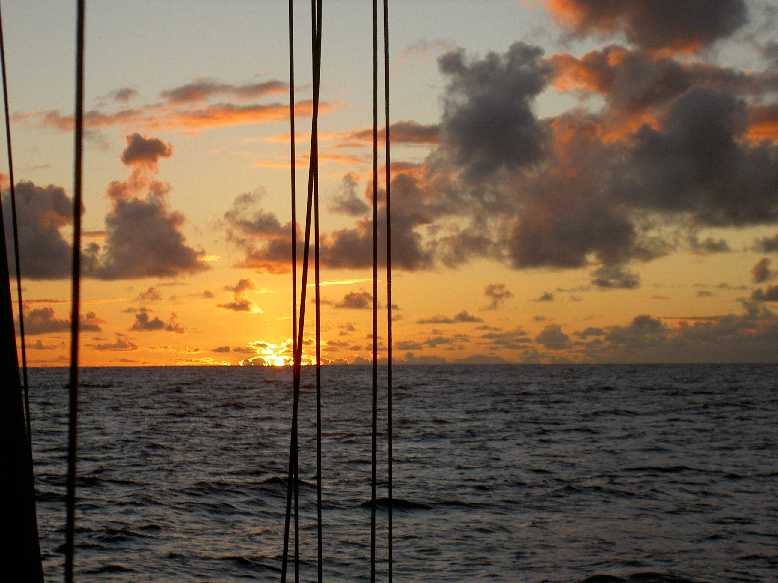
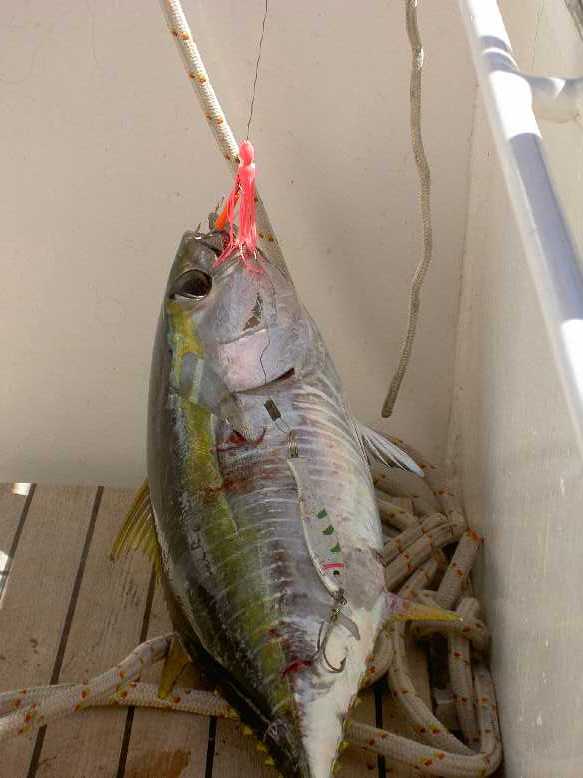
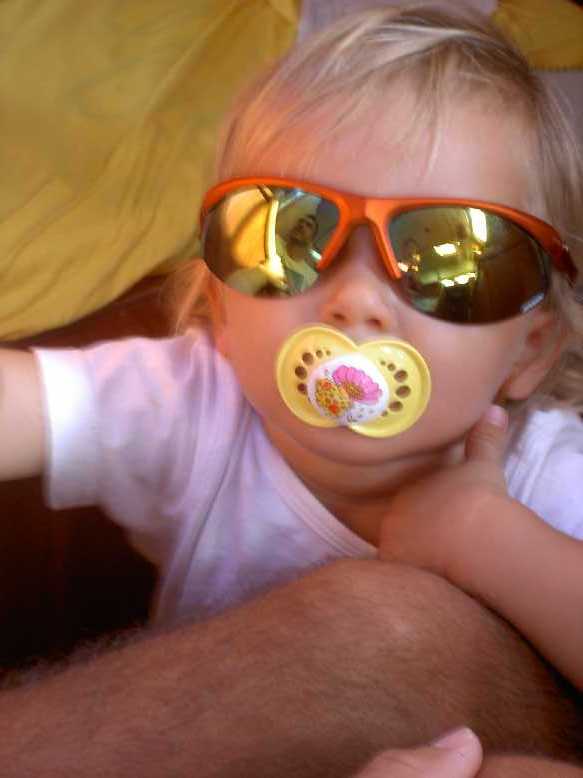
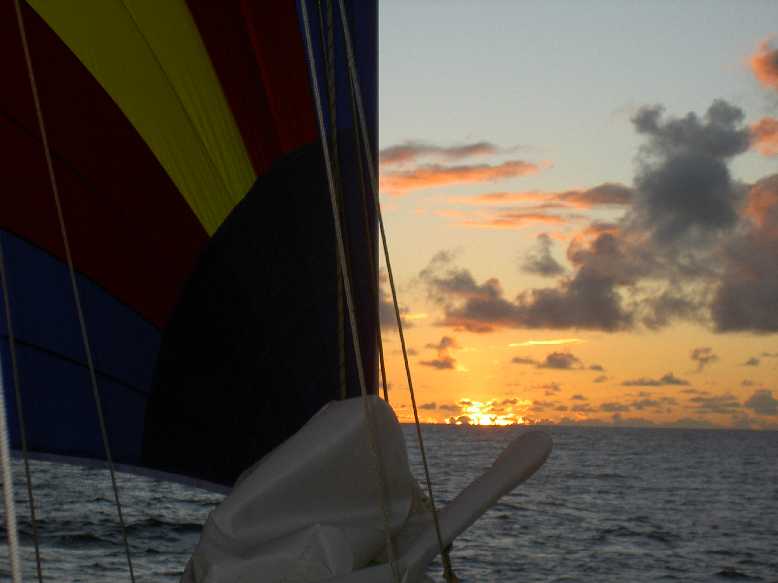
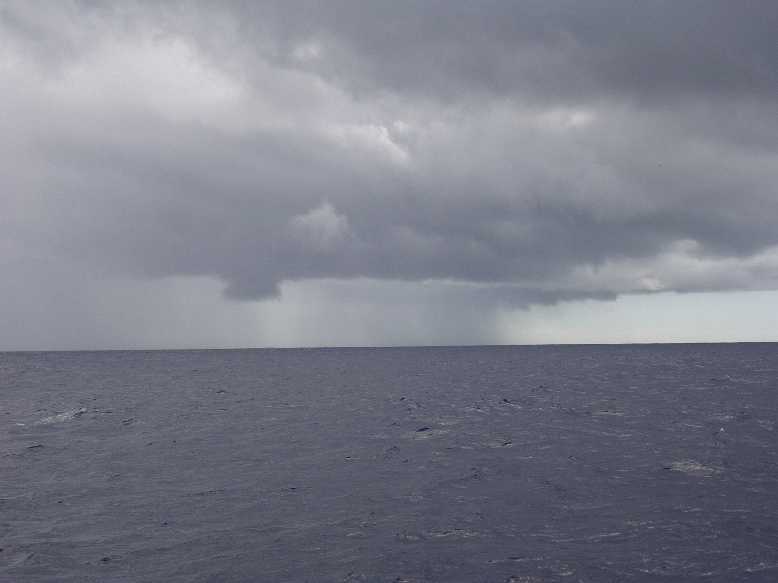
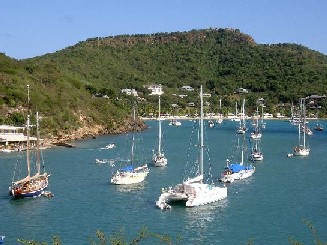
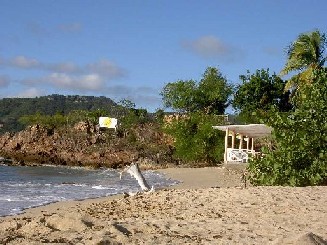
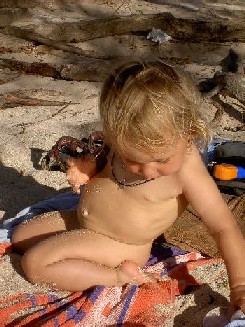
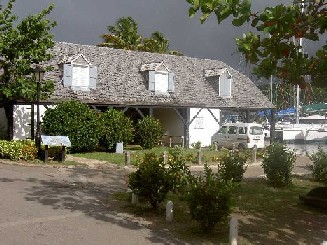
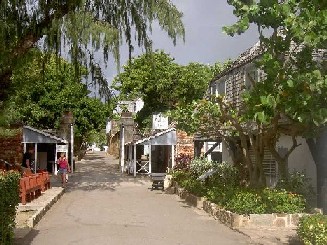
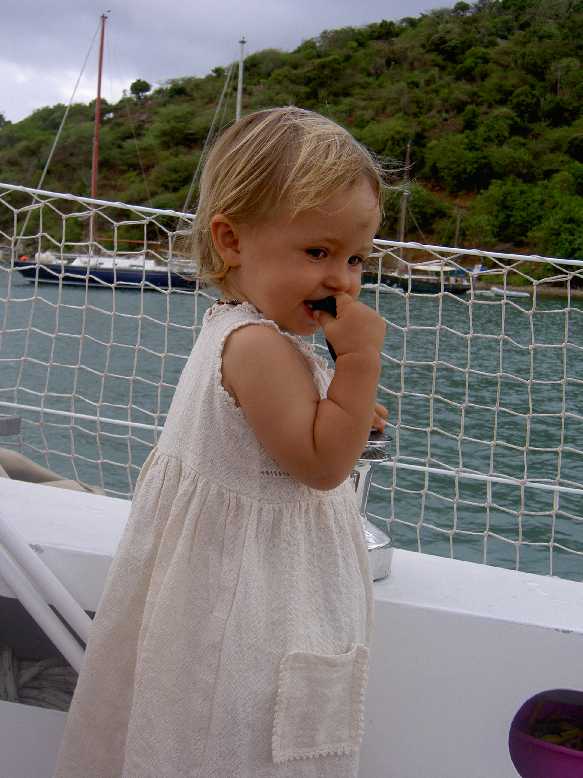
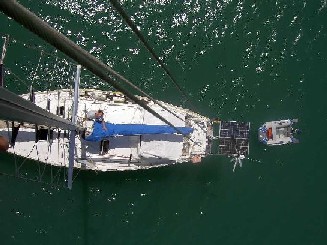

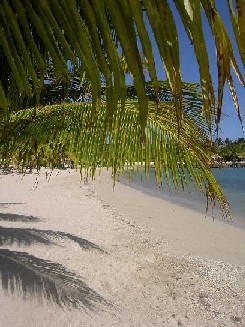
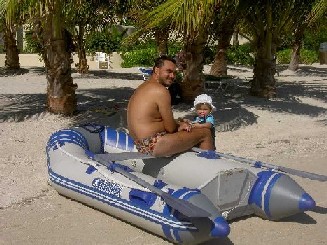
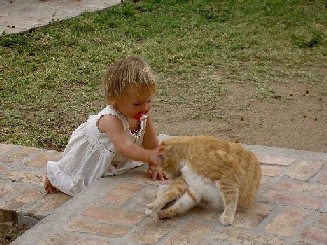
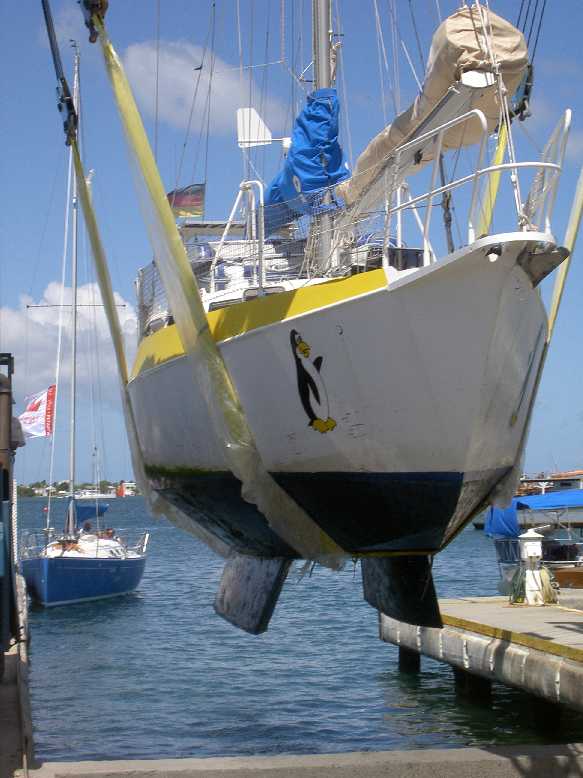
March: On Wednesday he started with sanding off the old antifouling and primering the additional parts for the antifouling. He really enjoyed this work, lying below the boat on the ground and pressing the sanding machine (1.5kg) against the hull. He suffered from some muscle ache the next day. On Thursday he put on three coats of antifouling on the hull, first time red, second one black and third one blue. You ask: „why three different colours?“ It's an easy answer: when one coat has worn off it will be easily visible and you are warned when the hull becomes red, as this was the first coat. As the size of the paint-containers fitted nicely with the size of the hull it was easy to perform one coat with one container. On Friday he started with his favourite work, sanding! All the old white paint at the hull had to be completely removed until the aluminium was visible. It took him nearly the whole day sanding and in the evening he was able to primer it all. He was lucky and had no big muscle ache the next days, but he and „Mimpi Manis“ were covered with fine white dust. But if you had seen the condition of the paint, you would agree that it was necessary to sand it off and repaint the hull. The old paint was in a very bad condition everywhere where it was in contact with water, although it was allowed to use her to cover the parts of the hull just above the antifouling, a part known to be exposed to water often. But now he put on a 2-component epoxyprimer and two coats of 2-component polyurethane paint. So on Saturday „Mimpi Manis“ became her first white coat and on Sunday the second. In the meantime he was able to take off most items on the To-Do-list and to change the cutless bearing of the shaft. On Monday (earlier then planned) „Mimpi Manis“ went back to her favourite element, water, again, showing her neatly white hull.
Being on the dry with a sailing boat is no fun at all, it's not only that you have to work from dawn to dusk and apart from this living conditions are very different too. So you can not go to the toilette on the ship, even hand washing or doing the washing up after the meals was always connected with getting down a steep ladder and a walk to the sanitary block. As you are not allowed to let off any water while on the dry first it would be an anger to yourself as than the new paint, probably not yet dry, would become wet and second where should all the water go, it would flow onto the yard and then? Inside the ship it was like being in the dessert, as it was dusty and virtually no wind made it inside. So temperature went up to 35°C during daytime and you start sweating even when doing nothing. Evi and Lena where glad not to be on board of „Mimpi Manis“ while she was on the dry, as a yacht yard is no playground, no green lawn, all dusty, lot of dust in the air and noise from the work and the nearby airport (the runway was just 50m away). So every boatowner works hard to get back into the water again asap.
By the way, one week on the dry took us 400$ and the antifouling was an additional 600$ for 3 Gallons (app. 11.4l). In Antigua they would have charged us 2500$ and only using 2 gallons of antifouling. So it was worth sailing to San Maarten, although we spent a lot of money on additional stuff for the boat as spare halyards, a new cutless bearing, a new radarreflector (we have lost the old one on the Atlantic), some brushes, ... But now we should be able to stay in the water for 2 years, let's see.
On Tuesday he took a bus to Philipsburg to do some sightseeing. But if you miss Philipsburg, you have not missed something interesting. Philipsburg see to consist of only two roads, one at the beach and covered with bars and restaurants and Backstreet covered with shops selling watches, t-shirts, souvenirs, jewellery and all the other stuff you need most. San Maarten is a duty free zone and so always lots of cruising ship populate the harbour and all those passengers want to go shopping. On his way back to Simpson Bay he compared prices in some supermarkets and he could not find a really cheap one. Tomatoes are 4$ per pound and are not really tasty, that's 8$ per kilo, so tomatoes went straight to the bottom of the shopping list. Let's see what he will buy to feed himself and his two ladies.
Hiipppyyy, we have a brand-new Dinghy and it is of course as yellow as a beak of a penguin! As most of the items on board of „Mimpi Manis“. It was not cheap but worth its price and we hope to stay dry when loading it up with the three of us, Lena's Buggy, and lot's of other stuff. Our old engine must do it, but we will for sure not speed it up to glide on the water, therefore we would need 10HP instead of the actual 5HP, as the new one weights 46kg instead of the 23kg of the old one. But we like it more to stay dry and slow instead of fast and wet. Evi doesn't know of the new dinghy, it's a surprise for her. The old one was good in the Mediterranean Sea but here in the West Indies we have more wind, higher waves and longer distances ashore. But to see here and Lena again means to sail all the way down to Antigua first. There's an appointment with „La Gitana“ and „Morgi“ on St. Kitts on the 12th of March. So setting sails and going there was finest downwind sailing. Indeed „Morgi“ was moored in the marina at Basseterre and waiting for „La Gitana“ which will come one or two days later as they had some business in the British Virgin Islands and US Virgin Islands. As the crew of „Morgi“ didn't know me I rowed up to them and introduced myself: „I'm Stephan from the „Mimpi Manis“!“ And the answer was: „I'm Edgar, come aboard and have a beer!“ That's what I call sailing, to know some other sailors and having not seen them before. And as soon as you get in touch with the others, you are friends. As I was not keen on staying in the harbour while waiting for „La Gitana“ and pulled up my anchor the next day and went to „White House Bay“ 5 miles south of Basseterre. There I dropped it into crystal clear water on soft sand. The day after next I heard the sound of beeping a horn, got out and saw Volker, Michaela, Edgar and Claudia standing on the beach and waving hands and arms. They had rented a car and were driving around the island on 4 wheels. So I got ashore and embraced with Volker and Michaela, not having seen them since beginning of December last year. Volker was staring jealously at our new dinghy. They promised to join „Mimpi Manis“ next day and they kept to their promise. Next day 10 minutes after the anchors of „Morgi“ and „La Gitana“ had dropped, Edgar and Volker were sitting in our dinghy and we motored from one snorkelsite to the next. On the same evening we had a really tasty meal on board of „La Gitana“ and it became one o'clock in the morning when the crews of „Morgi“ and „Mimpi Manis“ returned to their swimming homes. Unfortunately I had to leave next day afternoon to arrive in Antigua on time to pick up Evi and Lena. Leaving in the afternoon leads to sailing during night time. One could think that in the night time not many boats are out on sea, but lots of cruising ships are cruising during night time and they are going in circles or any other strange courses. During the day they are normally moored in a harbour and leaving at dawn to arrive in the next harbour at dusk. But distances here are so short that they have nothing to do in the night than waiting for dusk to come and so they are going in circles or cruising strange courses. So there's not must sleeping but going night shifts and hoping not to cross the course of a cruising ship. I was lucky and I could see not many (only two) cruising ships during that night. At dusk Antigua was pretty close and I arrived in „English Harbour“ at noon. Now I had to prepare the ship and this means doing a lot of laundry and cleaning the ship from the interior and exterior.
Next day evening Evi and Lena arrived but Lena was ill with a cold and fever, so saying hallo to her had to be postponed for the next day. After 3 weeks in the cold of winterly Germany it was no surprise that Lena got ill. There was really no day it did not snow and Evi was not able to persuade Lena to walk outside the house in the snow. Nevertheless they enjoyed their time in Germany although their were fully booked. Lots of meetings with relatives and friends, a wedding, a baptism, ... They changed their beds quite regularly. Thanks to all who supported us with providing a place to sleep or lent their car or took care on Lena while Evi hurried from one appointment to the next. On the 18th of March at the check in at the airport in Munich the friendly clerk asked Evi how she wants to get back to Germany. “A sailing boat, you are living on a sailing boat in the Caribbean Sea, unbelievable!” was here answer. “Have a nice trip and luck with immigration in Antigua!” And in Antigua immigration just asked her: ” Oh on a sailing boat, how long do you want to stay?” That was indeed easy! To cover the last few kilometres to English Harbour with a taxi was the last leg of this long journey. And Lena started to sleep the first time since they left London. Flying is just too exciting for little Lena to be missed. So we lay here into her bed and she slept till next morning when Stephan had some time to say hello to his beloved daughter. But next day we had to leave early in the morning to arrive in Anse Deshais on Guadeloupe in time to pick up Waldi and Alf our friends to join us for the next week.
Via SMS we told them to arrive at 4pm and indeed we managed to be there exactly at 4pm. Dropping our anchor next to the German sailing boat „Knaatsche“ we last met end of may 2005 in Pylos, Greece. With the new dinghy it is possible to load the three of us, Waldi, Alf and their luggage motoring back and not getting wet. The old dinghy would have become a submarine when trying this. As we did not want to sail a lot with our friends we started with a walk through the village of Deshais the next day. We tried to take the opportunity and clear immigration at customs. Stephan had a outclearance from San Maarten from the 10th of March (we arrived in Deshais on the 20th of March), on St. Kitts he had no inclination to clear immigration and on Antigua we only stayed for one night. But here in France things got complicated as customs was not closed but just not manned. A sign told us to go to Basseterre or Pointe a Pitre instead. But both harbours were not on our route for the next days so we left next day southbound still flying the yellow below the French flag.
As there was really no wind we had to motor for 10 miles to the Ile de Pigeon. This bay with the offshore island is part of the Jacques Cousteau-Marritime-nationalpark and a paradise for divers and snorkelling. After having dropped the anchor we realized that there was a snorkel paradise in our engine room, 30cm of water and everything inside was swimming. Lots of spareparts for the electric installation, filters, ... all wet and soaked with salt-water. Why the hell did the automatic bilge-pump not start? But that is work for the next day. Today we had to get all the water out first, using the electric and manual bilge pump. Than we used a sponch to get out the last drops of water and than we had to wash everything with sweetwater to get rid of the salt on the eginge, gearbox, buggy, .... On deck we tried to dry everything. Snorkelling was not on our list for today! Next morning we had to look where all the salt-water came from and we realized that the exhaust pipe has come of the swanneck and while motoring the engine pumped a lot of water inside the engine room instead outboard. So we had to remove the washing machine to get good access to the swanneck, remount the exhaust pipe and install the washing machine again. Our guest were impressed when seeing how a washing machine is removed and reinstalled again on a sailing boat. After that we took a look at the second fault, the automatic bilge pump. Some dirt has blocked the mechanism and so it was unable to switch on the pump. Some days later Stephan realized that the gearbox had difficulties when switching into the reverse gear. While looking for the reason he discovered water inside the gearbox which already has become a viscous liquid with the oil. Another result of our flooding. After several changes of the gearbox oil all difficulties dissolved. Especially Alf liked the way we dealt with our technical problems.
Repairs took less time than planned and so we were able to stay on the beach during the afternoon and go snorkelling. Next day morning a customs-boat was coming pretty close and taking deep looks at us. But luckily they went to check a Brazilian boat anchoring next to us. It would have been a nice discussion with customs when checking our papers, Stephan had cleared out in San Maarten two weeks ago, Evi and Lena had a arrival stamp from Antigua but no exit stamp and Waldi and Alf were not on our crewlist at all and we still had not passed immigration on Guadeloupe. So we aimed to clear immigration as soon as possible. We left for Iles des Saints, a group of small islands south of Guadeloupe. After leaving the lee of Guadeloupe we got some stronger winds and Waldi got a bit of green around her nose. After altogether 6 hours of sailing, first very light winds, then tacking against 5Bft and then motoring we finally reached the main village of the Iles des Saints and dropped our anchor.
Next day morning we tried to clear immigration but this was a public holiday so immigration was closed. Next day we tried again and we learned that the faxmachine was broken down so we were not able to hand over our papers. But the civil agent told us to go for Pointe a Pitre on one of the next days as we were heading there anyway. And some more days without a proper clearance should be no problem. We really tried to pass immigration but we were not allowed to.
Here on the Iles de Saint we enjoyed the marvellous landscape, the clear water and the nice beaches for sunbathing, swimming and snorkelling. The main island Terre de Haute is so small that all paths can be covered by foot easily. Even walking up to Fort Napoleon in the sun did not frighten us. One can say that sailors must do some walks from time to time not to loose their muscles. We enjoyed the beautiful views on the small bays of the island, also an interesting museum, huge leguans and a nice cactus garden.
As we only had one week with Waldi and Alf we had to leave the Iles des Saint and go back to Guadeloupe mainland. For the last two days we rented a car to drive all over the green island. We walked to the falls of Chutes du Carbet, having a good view on the volcano La Sufriere. Unfortunately we had to skip our walk around the lake „Grand Etang“ due to the swarms of hungry mosquitoes looking for some uncovered skin. On the coastal road we drove round the western part of Guadeloupe with a stop in Maison de Cacao, a overpriced Cacaomuseum. On the next day we went to the eastern part of Guadeloupe with it's beautiful beaches and the impressive cap Pointe des Chateaux. We led an idle life and preferred to stay in the turquoise water. We really enjoyed this week with lots of talks on news from home and playing games in the evening. But now it's time to say good bye and when will we meet again? At least in the Pacific on our way from Samoa to Kiribati. Alf wants to get to Kiribati (pronounced: Kiribass) once in his life. But it's not easy to get there and so we promised him to take him with us when we sail there. As Waldi is „not always insensitive to sea-sickness“ it will take him some time to persuade her to sail there.
When returning from the airport to the dinghylanding we had a notice from Volker and Michaela saying: „Hello the three of you, we are here in the marina and you are invited for a beer!“ To be invited for a beer is always a good reason to change plans and go for a beer. Edgar and Claudia from the „Morgi“ were also on board and so we ransacked the beerstorage of „La Gitana“. „La Gitana“ was lifted out the next day as they had problems with their cutless bearing. The mounting of the engine might be the reason for this problem. But unfortunately the mechanician was not able to solve the problem as the engine was mounted much too high and the mounting bolts were already at their limit. So the foundation of the engine has to be adapted, work for several days. So they agreed on a new attempt for mid of April to lifted out of the water again and have the problem solved. Why did the mechanician in July last year not adapt the engine foundation when he mounted the engine. Did he not see the problem? Than he is a really bad mechanician. Or did he see the problem and just had no intention to deal with it due to lack of time? But there were missing 2cm in height when you looked through the hole were the shaft is supposed to be. But now it will become a lot of work as the engine has to be unmounted, the foundation adapted, the engine remounted and adjusted. They also will need a new shaft and some other parts as a flexible coupling. Apart from the loss of time while on the hard stand it is also expensive to be lifted out of the water twice for a reason which was really avoidable. Let's hope that they can get the money back from the mechanician in France who mounted the engine last year. Warranty should last!
Next morning we left the anchor site at Pointe a Pitre which is not nice at all. By the way we have managed to clear immigration successfully! We motored to St. Francois and dropped anchor in a really nice lagoon with green or is it blue turquoise water. A nice beach for Lena is also available and so we stayed there for a couple of days. During daytime water temperature rises above 30°C and we were able to count sandgrains on the bottom in 3m depth. Lena enjoys the warm water while sitting in her yellow floating ring and having fun with mama and papa swimming next to her.

